A River in Peril
The Oregon spotted frog highlights where the Habitat Conservation Plan falls short.
The Northern spotted owl may be the most controversial animal in the Pacific Northwest. The owl was pushed into the national spotlight in the early 1990s as a focal point for the region’s infamous struggle between the timber industry and legal protections for Oregon and Washington’s old growth forests. For many people, the story was reduced to soundbites. Bumper stickers read, “Spotted owl – It’s what’s for dinner.” A 1990 New York Times headline read, “10,000 Are Expected to Lose jobs to Spotted Owl.”
Northwest spotted owl
We know this story wasn’t just about the spotted owl. The tale unfolded as a much more complex and nuanced account of an ecosystem’s health and the future of all species involved. It was a lesson in sustaining a forest that could replenish itself. It asked us to see the difference between old growth and secondary forests. And yes, it was also about the spotted owl and how many acres of old growth needed to remain if we wanted the species to survive.
This story was about seeing the spotted owls’ health as an indicator of forest health. If the owls couldn’t survive, there was little hope for the red tree vole or the pileated woodpecker. The lichen, mosses, and fungi were at risk. The forests would become hotter and drier.
What is an indicator species? A plant or animal whose presence is a signal of a healthy or unhealthy ecosystem.
In Deschutes County, the Oregon spotted frog has emerged as our area’s own indicator species, drawn into the regional spotlight through the Habitat Conservation Plan.
The Oregon spotted frog lives in rivers and lakes, wetlands and riverine sloughs. Born a dark olive green and emerging into a reddish-brown skin, you’ll know the amphibian by its thick, black spots. It winters in the Deschutes River’s oxbows, hiding behind aquatic grasses in the slow-flowing shallows for cover and protection.
Oregon spotted frog
The Oregon spotted frog was listed under the Endangered Species Act in 2014. According to Oregon Fish and Wildlife Service, the spotted frog has lost 78% of its original habitat area.
If you look at the banks of the river next time you stroll along the Deschutes on a winter day, you’ll see what once was flourishing spotted frog habitat. Since the completion of Wickiup Dam in 1949, the once stable flow of the Upper Deschutes is now highly volatile. In the winter, 95% of the water is held back by the dam, creating extremely low flows.
Former wetlands along the river bank are now mostly dry.
These flows freeze and dry the river banks, exposing vast mudflats where wetland sedges once grew. On your winter stroll, you can see the now-exposed mudflats and dry grasses along the riverbank that should be inundated by slow-flowing shallow water where the frog once thrived. This habitat is no longer a wetland, nor is it suitable for the frog. Instead, they are pushed out of sheltered areas and into the deeper and exposed currents. Between the pull of the water and the brown trout’s predatory eye, the spotted frog won’t make it to spring.
Because much of the river’s habitat degradation is connected to the irrigation districts’ control of the river flows, the Habitat Conservation Plan was proposed to mitigate the effects on this endangered indicator species.
The truth is, the Oregon spotted frog is nearly gone from the river. It’s a hard truth, but it tells us that the Deschutes River itself is on the verge of ecological collapse.
The Habitat Conservation Plan falls short.
We had hoped that the Habitat Conservation Plan would take the science into account and put forward a proposal that would restore the river and bring back a healthy ecosystem.
In 2017, the U.S. Fish & Wildlife Service concluded that the Deschutes River winter flows needed to be restored to a minimum of 600 cfs to save the Oregon spotted frog. We know from observation during the ramp down of flows in the fall that many wetlands along the river need 900 cfs for inundation and are dry by the time the flow drops to 600 cfs.
The Habitat Conservation Plan leaves former wetlands dry.
While the Habitat Conservation Plan was recently approved, the plan only increases the winter river flow to 400 cfs, and it takes 13 years to do so. This isn’t even close to what is necessary to restore critical habitat. We need more soon. This species doesn’t have a decade to wait.
Yes, this fight is about the Oregon spotted frog, but it is also about so much more. We can learn about the health of an ecosystem by looking at the species that thrive there. Just like the spotted owl gave us a glimpse into our forests’ wellbeing, the spotted frog is sending a clear message: our rivers are not healthy.
Will you become a champion for the Deschutes?
It’s time to take a stand for the river and the wildlife that calls it home. To do that, we need your ongoing support. Can you become a monthly sustaining donor to Central Oregon LandWatch to help us defend the river?




